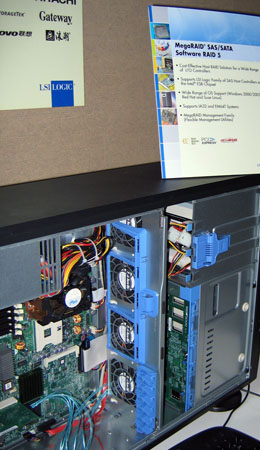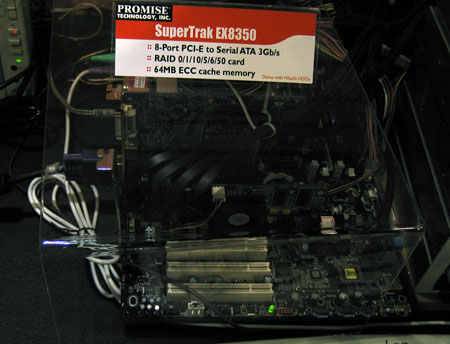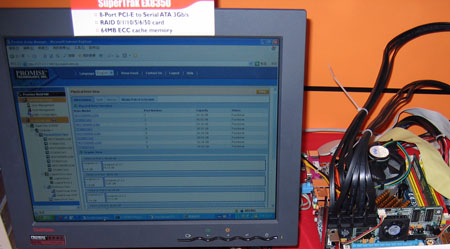Storage
Everyone and everybody couldn’t stop talking about Raid 6 at the show this year. Raid 6, for those not familiar, is a striping technology similar to Raid 5, but considerably more resource and CPU intensive. On the upside, a Raid 6 array can lose as many as two disks before failure, and even the loss of one or two disks will force the array to begin repairing itself in the background. The only downside to this technology, because it is so CPU intensive, is that it only comes in software form. The hardware is still needed to support Raid 6, but a software driver is what actually enables the technology. The other downside is that many disks are needed for Raid 6 to really become viable. Don’t expect to run this on your desktop to increase World of Warcraft performance – this is pretty much server level technology. There were also some new SAS and Infiniband controllers on the show floor at HighPoint, and those are technologies that we will definitely keep an eye on.
LSI
Besides their Raid 6 demonstrations, LSI also had a considerable amount of their suite dedicated to MegaRAID, their SAS and SATA software RAID 5 solution. While BSD operating systems have enjoyed Raid 5 software RAID via the OS for years, Linux and Windows have not been as fortunate. MegaRAID will support 32-bit and 64-bit operating systems.

Click to enlarge.
Promise
Below, you can see a shot of Promise’s Raid 8-port SATA controller with Raid 6 support and 64MB of ECC cache on board.

Click to enlarge.

Click to enlarge.
NetCell
Running from meeting to meeting, we met a very interesting employee from a company called NetCell. While we don’t have exact details at the moment, the NetCell employee mentioned that they were developing a transparent technology that built Raid 3 arrays. Raid 3 works similarly in the manner of Raid 5, but an entire hard disk is devoted to parity instead. Thus, one could lose an entire drive (or the parity drive) and still function fine. The advantage is performance – there are fewer duplicate writes – but a three-disk array only has the capacity of two disks. What NetCell aims to do is make this technology completely transparent to the user. Plugging three drives into the NetCell controller will set up the raid stripe automatically and further configuration is handled by the chip. Since there is no CPU overhead (unlike Raid 6), NetCell might have a pretty interesting technology in the near future – particularly for gamers and enthusiasts.
35 Comments
View All Comments
Yawgm0th - Thursday, June 2, 2005 - link
Windows has had software RAID 5 for years, too...ProviaFan - Thursday, June 2, 2005 - link
Which brings to mind that I seem to recall the Server editions of Windows being able to do software RAID as well...bersl2 - Thursday, June 2, 2005 - link
Um... I think some fact checking needs to be done about this statement:"While BSD operating systems have enjoyed Raid 5 software RAID via the OS for years, Linux and Windows have not been as fortunate."
http://www.tldp.org/HOWTO/Software-RAID-0.4x-HOWTO...
This old document puts RAID 5 in the kernel, in a working, if not feature-complete, form in 1997 (2.1.63).
http://www.tldp.org/HOWTO/Software-RAID-HOWTO-1.ht...
This more recent version of the HOWTO places an updated version of RAID at no later than Jan. 2001 (2.4.0---and that's not counting it being in any development series kernels).
ProviaFan - Wednesday, June 1, 2005 - link
Yeah, I wonder where all these high-res displays are that Longhorn is supposedly going to support...Thanks anyway for the comprehensive coverage!
Tarumam - Wednesday, June 1, 2005 - link
Nice coverage. Wonder what´s wrong with the LCD guys though.